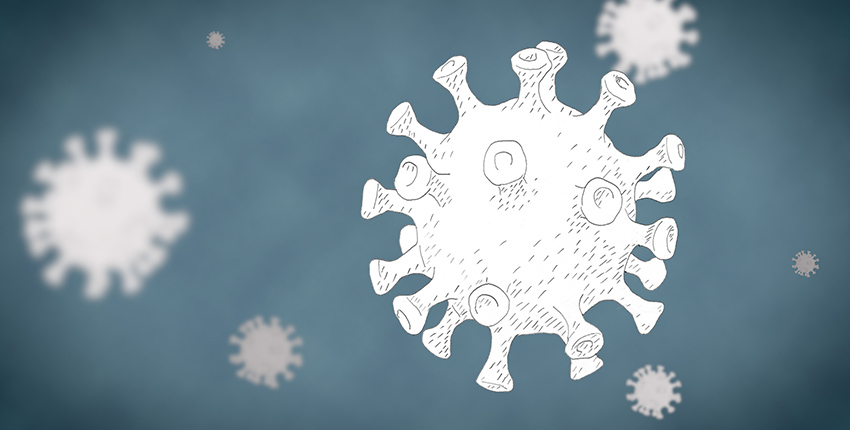
This article is part of Harvard Medical School’s continuing coverage of COVID-19.
Scientists have discovered a possible new way to fight COVID-19 by turning part of SARS-CoV-2 against itself.
This new strategy shows promise in mice and in human cells in a lab dish, according to the team led by researchers from the Blavatnik Institute at Harvard Medical School and Boston Children’s Hospital.
The study offers an innovative approach for scientists working to develop drugs that attack SARS-CoV-2 and other harmful viruses. Such drugs could work across many SARS-CoV-2 variants because the strategy targets a part of the viral genome that doesn’t often mutate.
Findings were reported Feb. 11 in PNAS.
“Despite the successful rollout of vaccines against COVID-19, the world still urgently needs effective therapies that stop infection in its tracks,” said co-first author Setu Vora, research fellow in biological chemistry and molecular pharmacology in the lab of Hao Wu at HMS and Boston Children’s. “It would be amazing if this strategy could ultimately be harnessed into a new treatment.”
The experimental treatment described in the current study, as well as any others that it may inspire, is still far from hitting hospital beds and pharmacy shelves. It must progress through further animal studies and human clinical trials to demonstrate whether it would be safe and effective in people.
“More broadly, going forward, we hope that our findings provide insights into viral pathogenesis and therapeutic strategies in general,” said co-senior author Wu, the Asa and Patricia Springer Professor of Structural Biology and professor of biological chemistry and molecular pharmacology at HMS and Boston Children’s.
How it works
When it infects a host cell—whether human or mouse—SARS-CoV-2 strikes a balance between allowing the cell to continue to make its own life-sustaining proteins and manipulating the cell into churning out viral proteins that form copies of SARS-CoV-2 instead.
The balance ensures that the cell produces just enough of its own proteins to stay alive while devoting most of its energy to replicating the virus, which can then go on to infect more cells.
The research team found that two parts of the virus contribute to this balance.
One, a viral protein called Nsp1, reduces the cell’s ability to make any proteins at all.
The other, a tiny segment of viral RNA called stem loop 1, serves as an access card to get past Nsp1 and instruct the cell to make more viral proteins.
The researchers wanted to revoke that access.
They designed a short piece of an RNA-like molecule—called an antisense oligonucleotide, or an oligo for short—that attaches to stem loop 1 and blocks it.
The team suspected that covering up the access card would make Nsp1 quash viral protein production right alongside host cell protein production, said Vora. As the cell produced fewer viral proteins, infection would wane.
Essentially, the therapy would trick SARS-CoV-2 into thwarting itself.
“Once the oligo binds, stem loop 1 can’t work anymore. The virus is shut down by its own Nsp1,” said Wu.
Early promise
The team tested the treatment in lab dishes of human cells and in mice engineered to have human ACE2 receptors—the cell-surface proteins that SARS-CoV-2 uses to latch onto and enter cells.
As hoped, treated cells made about one-fourth as many viruses as untreated ones, and treated mice were protected against dying from SARS-CoV-2-infection. Whereas only 20 percent of untreated mice survived infection, 60 percent of those that received the oligos recovered. Treated mice also lost less weight during infection than untreated mice.
“The therapy stopped the virus from evading its own translational suppression,” said co-first author Pietro Fontana, research fellow in biological chemistry and molecular pharmacology in the Wu lab. “It inhibited viral replication.”
Because Nsp1 is itself a viral protein, treated cells likely make less of that, too, the team speculates. Over time, they propose, Nsp1’s chokehold should ease, and the cells could make healthy amounts of their own proteins again.
Next steps
The idea behind SARS-CoV-2 antivirals currently on the market is to make it harder for the virus to replicate in the body, thus reducing viral load and lessening symptoms. The team’s method aims to do so as well, but in a different way. Paxlovid, for example, a combination of nirmatrelvir and ritonavir, disrupts the function of certain proteins required for viral replication, while molnupiravir introduces mistakes when a cell tries to copy the viral genome.
A unique benefit of the oligo treatment is that it may discourage the virus from developing resistance to it. Because stem loop 1’s genetic code is so unchanging across variants, the team predicts that if it were to evolve a mutation that allowed it to escape the oligo, that mutation would itself compromise the virus’ ability to replicate.
“Our strategy makes the virus choose: either be killed by our oligo or evolve to become less hostile to human cells,” said Vora.
The study provides another leg up for researchers who pursue it further. Oligos are already used in about a dozen drugs that are FDA-approved for patients with specific genetic mutations that cause certain types of brain cancer, breast cancer, inherited high cholesterol, muscular dystrophy, and other diseases.
Wu is co-senior author of the paper with Akiko Iwasaki of Yale University; Ming Shi, research associate in biological chemistry and molecular pharmacology at HMS and Boston Children’s; and Longfei Wang, a former instructor in biological chemistry and molecular pharmacology at HMS and Boston Children’s, now at Wuhan University in China.
This work was supported by the Cancer Research Institute, National Institutes of Health (5T32AI007512-34, 5T32HL066987-18), American Cancer Society (133083-PF-19-034-01-LIB), and the Ohio State University Comprehensive Cancer Center. Microscopy experiments using the ImageXpress high content imaging system were performed at the HMS ICCB-Longwood Screening Facility.



